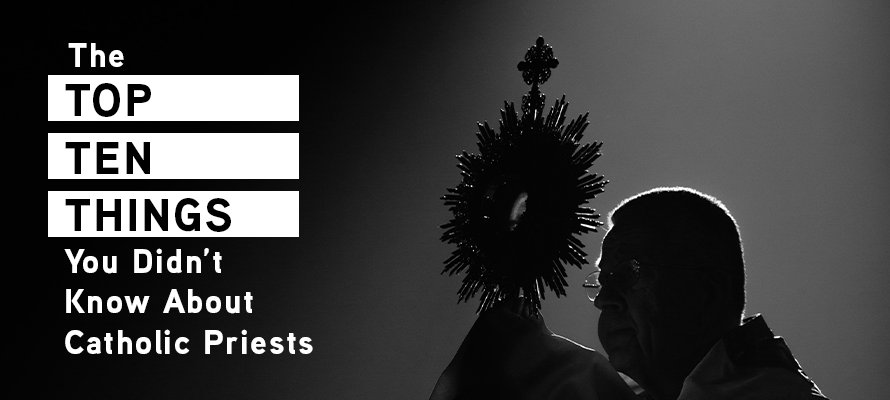
10. Priests aren’t obligated to celebrate the Mass every day.
No, priests aren’t required to celebrate the Mass every day. However, through the sacrament of Holy Orders, the priest has promised to pursue holiness and serve his people. What better way to do both than through the Sacrifice of the Mass? By celebrating the Mass daily, the priest is opening himself and his people to a multitude of graces and educating those under his care about the Word of God – their way to eternal life. If possible, priests are always encouraged to celebrate Mass each day. In fact, most of them regularly do.
9. Sometimes they wear rings.
In the Catholic Church, rings are primarily used to signify one’s vocation. The most well-known instance where someone wears a ring is in the sacrament of Matrimony, or marriage. In this ritual, the ring symbolizes the unity of the couple and is a daily reminder of their commitment to one another. Similarly, some priests and religious also wear rings to remind them of their daily commitment to the Church. Religious sisters and nuns will oftentimes wear rings as a part of their habit, as they are the spouse of Christ. Priests will wear rings as well, as they are the spouse of the Church. Most often, the priests wearing rings are those anointed as bishops, who wear it as a symbol of the authority bestowed on them by the pope.
Rings can also act as sacramentals, or something that points you toward holiness. A lot of devotions, prayers, and saints can be portrayed on rings, and may be worn because the priest has a connection, much like one would wear saint medals or a crucifix around their neck.
8. They do get paid and pay taxes.
Diocesan priests – priests who work for the diocese and aren’t in a particular religious order – do technically get paid. They do not take a vow of poverty upon being ordained, although the modesty of most churches’ finances ensures they maintain a simple lifestyle. What a priest is required to purchase from his own wages varies from parish to parish, but most common would be vehicles, clothing, leisure activities, and other items not directly related to their duties in the church. Because they are paid a [modest] wage, they too partake in the joy that is filing taxes.
7. Your priest may have had a previous career.
Just like normal people, priests could have a past where they experienced different careers and jobs before taking their vows for the priesthood. While many seminarians start studying for the priesthood immediately after graduating high school, it is not at all uncommon for men to go to college for a few years, graduate with a degree, or work in a particular field before beginning the path to the priesthood. Many priests don’t even enter seminary until their late 20s, 30s, or 40s!
6. They might live with their bride – the Church!
Depending on the age, size, and population of a parish, priests may or may not live in the church themselves. It is very common in older churches – mostly those built before the 1950s – to have a rectory attached to the church so the priest can live conveniently close to the place where he has his ministry. In more modern churches, a rectory is not included in the churches’ structures. A priest oftentimes will opt to live in a separate house located on the same property as the church, or in a home that is nearby, like across the street or a block away.
5. All priests don’t have the same mission.
Sure, the mission of the priest is to get people to Heaven. Every priest is definitely called to that through their vows. But not all priests have the same lifestyle. Diocesan priests answer to the bishops of their diocese, don’t take a vow of poverty, and tend to the needs of the people in their parish. Religious priests (Dominicans, Benedictines, Franciscans, etc.), however, do take a vow of poverty, live in community with their order, and are obedient to a Superior. Their days follow a regimented schedule of prayer, meals, work, and recreation. Oftentimes specific orders have a mission, like teaching or caring for people in a certain area, and they don’t receive a salary, but any money they collect goes toward the needs of their community.
4. Priests can’t absolve their own sins.
Unfortunately, priests don’t have a secret superpower that allows them to forgive their own sins. Just like everyone else, they must go to a priest themselves to receive the sacrament of Reconciliation. This practice of a priest seeking absolution from a fellow priest allows for advice, direction, and an awareness of sins that need to be worked on. Also, priests are human, too! They are sinners as well and must frequent the sacraments on their lifelong journeys to heaven, just like everyone else.
3. They are allowed to drink.
This may be shocking to many people, but priests are indeed allowed to enjoy alcoholic beverages. They don’t profess any vows that prohibit them from drinking – so as long as they are of drinking age, haven’t made any personal decisions to not drink alcohol, and are able to access it – they are definitely allowed to imbibe. In fact, Catholic monks from the Middle Ages are credited with the spread of modern-day beer brewing and would often spend the season of Lent (an entire 40 days!) drinking nothing but beer. However, they shouldn’t imbibe so much that they become inebriated or lose their free will.
2. Some priests are married.
Yes, married Catholic priests do exist, but in the grand scheme of things, they are rare. The Catholic Church is broken down into many rites, with Roman Catholicism being the largest rite by far. Some of the smaller rites, like the Byzantine rite, will ordain men to the priesthood that are already married. Another occasion that allows married priests is when a married pastor or priest from another denomination (like an Anglican) converts to Catholicism. He could be ordained as a Catholic priest and still be married to his wife.
1. They are satisfied with their vocation.
Despite the recent attacks on the priestly vocation, the priesthood carries with it a high satisfaction rate. Many priests find great joy in their vocations and express extreme gratitude for the love and generosity of the parishioners entrusted to them. Even more, priests enjoy getting to know their parishioners and watching them grow deeper in their faith – an opportunity found regularly in pilgrimages to holy places!




